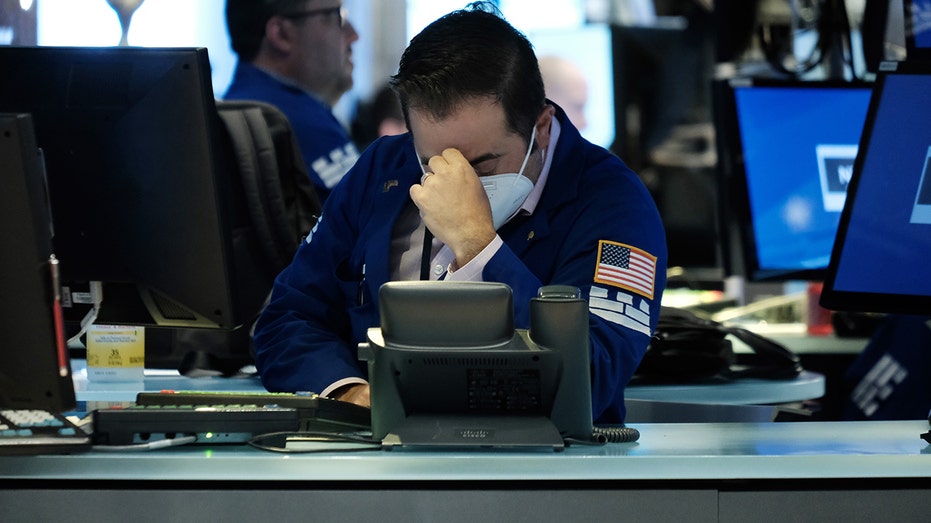Is a recession coming? Signs the economy is beginning to crack
Recessions are notoriously difficult to predict, but here are signs of a looming slowdown
Fed's Bullard on potential for US recession
St. Louis Fed President James Bullard forecasts a 'pretty good second half of the year' despite economic headwinds.
Wall Street is increasingly convinced that the Federal Reserve is going to drag the economy into a recession with its war on inflation.
Bank of America, Deutsche Bank, Wells Fargo and Goldman Sachs are among the most notable firms forecasting the possibility of a downturn within the next two years, as the U.S. central bank moves to aggressively tighten monetary policy in order to cool consumer demand and bring inflation back down to its 2% target.
There are growing signs the banks may be right, although recessions are notoriously difficult to predict.

A man shops at a Safeway grocery store in Annapolis, Maryland, on May 16, 2022, as Americans brace for summer sticker shock as inflation continues to grow. (JIM WATSON/AFP via Getty Images / Getty Images)
Here is a closer look at some signs the economy is beginning to splinter.
GDP unexpectedly shrank in the first quarter
Economic growth in the U.S. is already slowing.
The Bureau of Labor Statistics reported earlier this month that gross domestic product unexpectedly shrank in the first quarter of the year, marking the worst performance since the spring of 2020, when the economy was still deep in the throes of the COVID-induced recession.
ONE OF BIDEN'S FAVORITE ECONOMISTS SEES A HIGH CHANCE OF RECESSION IN NEXT 2 YEARS
GDP contracted by 1.4% on an annualized basis in the three-month period from January through March, according to the government's first reading of the data. That was sharply below Refinitiv economists' expectations for growth of 1.1%, and suggested that dark clouds are looming on the horizon.
"The shock drop in GDP is a wake-up call that the economy isn’t as strong as we all thought," said Chris Zaccarelli, chief investment officer for Independent Advisor Alliance. "It’s possible that GDP gets revised higher next month, as this is just the first release and there will be two revisions, but it is a warning sign."

Traders work on the floor of the New York Stock Exchange (NYSE) on May 18, 2022, in New York City. (Spencer Platt/Getty Images / Getty Images)
Recessions are technically defined by two consecutive quarters of negative economic growth and are characterized by high unemployment, low or negative GDP growth, falling income and slowing retail sales.
Market tumbling
Markets have gotten obliterated in a widespread sell-off this month as high inflation, rising interest rates and the risk of a recession have rattled investors.
Stocks In This Article:
The benchmark S&P 500 tumbled more than 20% this year, officially entering a bear market on Friday afternoon for the first time since March 2020, at the start of the COVID-19 pandemic. The Nasdaq Composite, meanwhile, is already deep into its own bear market, while the Dow Jones Industrial Average has also plunged for nine consecutive weeks.
Fed tightening
The Federal Reserve is hoping to achieve the rarest of economic feats as it moves into full inflation-fighting mode: cooling consumer demand enough so that prices stop rising, without crushing it so much that it throws the country into a recession.
Although Fed policymakers are counting on finding that elusive sweet spot — known as a soft landing — history shows that the U.S. central bank often struggles to successfully thread the needle between tightening policy and preserving economic growth.
Recent research from Alan Blinder, a former Federal Reserve board vice-chairman and a Princeton economist, identified 11 tightening cycles since 1965, of which eight were followed by recessions. Still, that doesn't mean a severe recession is guaranteed: There were five instances of either very mild recessions in which GDP fell less than 1% or there was no economic decline at all.
BANK OF AMERICA ANALYSTS SLASH S&P 500 PROJECTIONS AS 'SPECTER OF RECESSION' LOOMS
Fed policymakers hiked the benchmark federal funds rate by a half point earlier this month, and Chairman Jerome Powell has all but promised that two, similarly sized increases are on the table at the forthcoming meetings in June and July. He has echoed that sentiment as the Fed races to catch-up with runaway inflation and bring it back down to the 2% target, promising the Fed will raise rates as high as needed to cool prices.

In this Jan. 29, 2020 file photo, Federal Reserve Chair Jerome Powell pauses during a news conference in Washington. (AP Photo/Manuel Balce Ceneta, File / AP Newsroom)
"What we need to see is inflation coming down in a clear and convincing way and we’re going to keep pushing until we see that," he said Tuesday during a Wall Street Journal live event. "If that involves moving past broadly understood levels of neutral we won’t hesitate at all to do that."
Hiking interest rates tends to create higher rates on consumer and business loans, which slows the economy by forcing employers to cut back on spending.
"The Fed is attempting to thread the needle while wearing boxing gloves and a mouth guard, which reduces its degrees of freedom to act without causing damage to the real economy," said RSM chief economist Joe Brusuelas, who has questioned whether the central bank will be able to achieve a soft landing.
Inflation
The closely watched April consumer price index was supposed to show that sky-high inflation had peaked and that prices were starting to moderate.
Instead, prices actually rose more than expected in April, suggesting that inflation will persist at elevated levels for some time: While the Labor Department reported that the headline inflation figure did in fact moderate for the first time in month, the gauge still soared by 8.3%, a markedly fast pace that is close to a 40-year high.

Fruit is displayed inside a store on May 12, 2022, in New York City. (Spencer Platt/Getty Images / Getty Images)
At the same time, a different gauge that measures prices excluding food and energy – more volatile measurements – jumped by 0.6%, exceeding all estimates.
GET FOX BUSINESS ON THE GO BY CLICKING HERE
"This is another upward inflation surprise and suggests that the deceleration is going to be painstakingly slow," said Seema Shah, chief strategist at Principal Global Investors. "The focus will soon start shifting from where inflation peaked to where it plateaus, and we fear that it will plateau at an uncomfortably high level for the Fed."





















